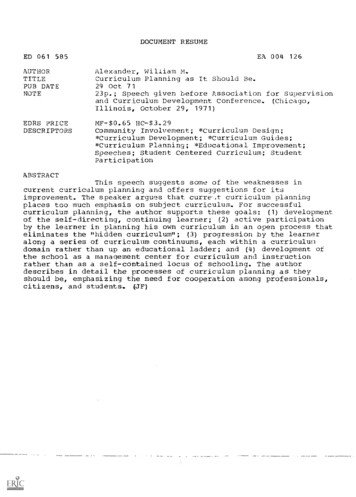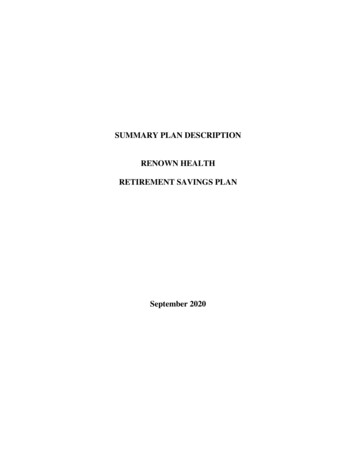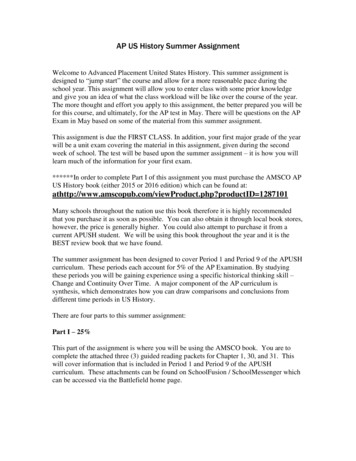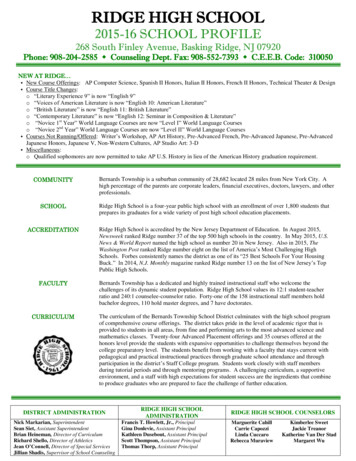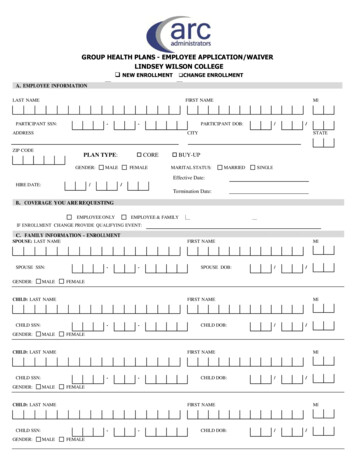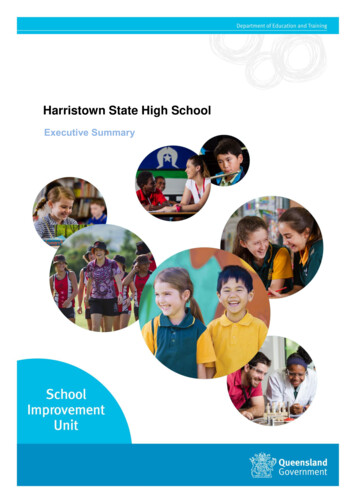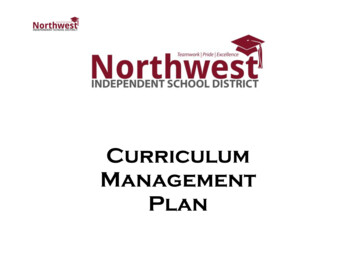
Transcription
CurriculumManagementPlan
Board of TrusteesPresidentJosh WrightVice PresidentMark SchluterSecretaryDevonna HollandMembersJudy CoppMel FullerLillian RauchAnne Simpson, Ph.D.ii
AdministrationSuperintendent of SchoolsKaren Rue, Ed.DAssistant Superintendent for Curriculum & InstructionRobert Thornell, Ed.D.Executive Director of Curriculum and Staff DevelopmentStephanie Espinosa, Ed.D.Executive Director of Elementary EducationMichael Griffin, Ed.D.Executive Director of Secondary EducationLinda Parker, Ed.D.Executive Director of Student ServicesJennifer Alexander, Ed.D.Executive Director of Fine ArtsKevin Lacefield, Ed.D.Director, Career and TechnologyTony NeelyDirector of Special EducationTracy CartasDirector of Career and College ReadinessKyle SeippCurriculum CoordinatorsBrittnie Bragg – ELA SecondarySunni Johnson – ELA ElementaryMelanye Griffin – Math SecondaryShelley Ingram – Math ElementaryTerry Ward – Science SecondaryTammy Motley – Science ElementaryDarsi Bickley – Social Studies Secondary & ElementaryLinda Denning – Advanced AcademicsCyLynn Braswell – Outdoor Learning Centeriii
Core BeliefsWe believe that: Kids come first Continuous improvement is essential for future success The success of each student is the shared responsibility of students, families, schools, and community Environment influences learningVisionNorthwest ISDThe best and most sought-after school district where every student is future ready: Ready for college Ready for the global workplace Ready for personal successMissionNorthwest ISD, in partnership with parents and community, will provide all students a premier education,preparing them to be successful, productive citizens.iii
Profile of a GraduatestAs 21 century citizens, Northwest Independent School District (NISD) students must be prepared with high levels of academicstrength including literacy, digital skills, critical thinking, problem solving, collaboration, and communication. The mission of NISD isto provide a premier education, preparing all students to be successful, productive citizens. Embedded in our vision is that ourstudents will be future ready: ready for college, ready for the global workplace, and ready for personal success. To accomplish thisgoal, a student who graduates from NISD will be:Ready for CollegeTo prepare to be future ready, a student who graduates from NISD will: Engage in relevant literacy through proficiency in reading, writing, listening, and speaking. Employ proficient and responsible use of digital media to effectively communicate, synthesize, and create newknowledge. Problem solve and critically analyze with determination to take risks, learn from mistakes, and adapt to new thinking. Determine validity and relevance of information resources in the development of research skills.Ready for Global WorkplaceTo prepare to be future ready, a student who graduates from NISD will: Connect and correlate knowledge and skills continuously through real-world applications in reading, writing,mathematics, science, social studies, the arts, and enrichment experiences. Construct new ideas through original and innovative thinking. Exhibit vision for personal learning and forward thinking to prepare for the future. Understand and adapt responsibility to a changing global community.Ready for Personal SuccessTo prepare to be future ready, a student who graduates from NISD will: Practice ethical behaviors exhibiting integrity, respect, and commitment within a well-balanced lifestyle. Show initiative and responsibility through positive actions to express self-motivation, self-discipline, and perseverance. Communicate and collaborate by exercising a willingness to help and connect with culturally diverse individuals andgroups to make necessary compromises toward accomplishing a common goal. Prepare for the unknown by being empowered with tools to face challenges and life-long learning.iv
Table of ContentsCurriculum Philosophy . 1Purpose of the Curriculum Management Plan . 1Northwest ISD Four-Year Strategic Plan 2014-2018 . 2Curriculum Alignment Definitions . 3Curriculum Development, Customization and Revision Process . 7Curriculum Design & Component . 8Rigorous Curriculum Model Components . 9Aligned Standards Curriculum Components . 10Aligned Instruction Curriculum Components . 11Aligned Assessment Curriculum Components . 14Data Analysis . 15Curriculum Audit. 17Curriculum Monitoring . 19Curriculum Evaluation . 22Professional Development. 23CURRICULUM SUPPORT – ROLES AND RESPONSIBILITIES . 24Guidelines for New Courses, Initiatives, Programs and Materials . 27Financial Support . 30Glossary . 31Bibliography. 34v
Curriculum PhilosophyThe Northwest Independent School District believes the purpose of education is to prepare all students to be successful, productivecitizens. In conjunction with our District’s Strategic Plan, Northwest ISD will design dynamic learning experiences to ensure that allstudents are future-ready learners. Premier instruction aligns the written, taught, and assessed curriculum, and reflects a standardof high expectations for student achievement. Premier instruction takes place in an engaging environment, incorporates engagingwork, and results in engaged learners. Premier instruction is a collaborative effort shared by students, parents, community partners,teachers, principals, central administrative staff, the superintendent, and the Board of Trustees.The development of the core and enrichment curriculum is research-based, data driven, and developed with an awareness of futuretrends. An ongoing cycle of curriculum design, delivery, monitoring and evaluation ensures continual program improvement andenhanced student achievement. The management of the curriculum is guided by strategic planning, including the NISD core beliefs,vision, and mission.Purpose of the Curriculum Management PlanThe Curriculum Management Plan (CMP) is designed to support the mission of the Northwest Independent School District (NISD) toprovide all students a premier education preparing them to be successful, productive citizens. NISD is committed to continuousimprovement of teaching and learning to produce graduates that are future-ready. The design and implementation of the curriculumis consistent with the district’s goals, mission, state law and State Board of Education rules. The Curriculum Management Plan detailsa systematic, on-going program of curriculum development, assessment, implementation and evaluation of the curriculum.The CMP provides clear direction for students, teachers, and administrators. It establishes a framework that outlines guidelines andprocedures for the design, delivery, monitoring, and evaluation of curriculum (See Figure 1). NISD understands that student learningis the result of well-written aligned curriculum delivered by highly-qualified teachers using sound instructional practices.While instructional differentiation shall occur to address the unique needs of all students, instruction must be delivered from acommon set of standards and curriculum objectives. This plan helps to ensure equitable access to the curriculum for all students, sothat all graduates of NISD are ready for college, ready for the workplace, and ready for personal success.1
Figure 1: Curriculum Management Plan ComponentsCurriculum Management Plan ComponentsCurriculum DesignA documented curriculum management plan includes thephilosophical framework for the design of the curriculum anddescribes the timing, scope, and procedures for curriculumreview. The plan also presents the format and components ofaligned curriculum guides.Curriculum MonitoringA documented curriculum management plan presentsprocedures for monitoring curriculum delivery in order todetermine whether approved curriculum is implementedconsistently in classrooms.Curriculum DeliveryA documented curriculum management plan provides directionfor curriculum delivery. The plan identifies a comprehensivestaff development program linked to curriculum design anddelivery.Curriculum EvaluationA documented curriculum management plan specifiesassessment procedures to determine curriculum effectivenessand describes the approaches by which assessment data will beused to strengthen curriculum and instruction.Northwest ISD Four-Year Strategic Plan 2014-2018Operational Goal INorthwest ISD will design dynamic learning experiences to ensure that all students are future-ready learners.TargetedObjective ATargetedObjective BTargetedObjective CTargetedObjective DTargetedObjective EDesign and implement curriculum that incorporates the learning requirements of future-ready students asidentified by the NISD Profile of a Graduate.Transform the learning environment through choice, relevance, and engagement.Advance collaboration, creativity, imagination, and innovation through differentiation and multi-dimensionallearning.Provide personalized anywhere/anytime learning through the integration of evolving digital resources.Facilitate healthy life choices to advance student health, productivity, and well-being.2
Curriculum Alignment DefinitionsIn keeping with the goals and objectives of the NISD’s mission, vision, Profile of a Graduate and Strategic Plan goals, we will createan aligned curriculum that promotes success for all students. The CMP is based upon the following definitions and principles aboutcurriculum design, delivery, monitoring, and evaluation.Written CurriculumWritten Curriculum is defined as those standards and goals that students are to achieve and teachers are to teach. Teachers arerequired by board policy to deliver the written documents. Since the curriculum is a system decision, not a campus or employeedecision, curriculum proposals must be approved by central administration. Written curriculum for Northwest ISD will contain thefollowing components: state standards which are aligned to district developed and criterion-referenced assessments; a scope andsequence with suggested pacing schedules, aligned resources; and examples of instructional strategies.Guiding principles for the management of the written curriculum include: a curriculum that prepares all students to be future-ready while adhering to state laws, State Board of Education rules, aswell as state and federal requirements a curriculum that involves students, teachers, principals, curriculum coordinators, parents, and/or community members, asappropriate a curriculum that is based on a set of non-negotiable, relevant and challenging student standards which guide decisionsabout teaching and learning and which are aligned vertically (PK-12), horizontally and systemically across campuses a curriculum developed to ensure that students from teacher-to-teacher and campus-to-campus have the same opportunityto learn the same standards at each instructional level a curriculum that is accessible, manageable, use-friendly, and current a curriculum that is reviewed and updated regularly at all levels: district, campus, and classroom.Taught CurriculumTaught curriculum refers to the delivery of the written curriculum. It is the process that is used by teachers to develop units of study,lesson plans, and/or approaches to instruction for teaching the written curriculum. Guiding principles for the management of thetaught curriculum include: a classroom instruction that is aligned to the district curriculum3
professional development for teachers to fully understand curriculum standardsan analysis of each objective so that instructional strategies match content and assessmentinstructional resources and programs such as textbooks, software, community resources, and other materials based upontheir alignment within the written curriculumexpectations that all students will perform at high levelsa varied pace for learning according to the needs of each student and the complexity of the taskopportunities for teachers to sue flexibility and creativity in their approach and practice time for student learning success.Assessed CurriculumAssessed curriculum is that portion of the written curriculum that is measured both formally and informally, to evaluate studentprogress toward mastery of the written curriculum. Teachers will use formative assessments to determine student achievement ongiven curriculum objectives and standards. Assessment data is used to make curriculum decisions for classroom instruction andindividual student needs.Guiding principles for the management of the assessed curriculum include acquisition, analyses, and communication of studentachievement data to: guide lesson design and instruction at appropriate levels of cognition guide student learning guide district/campus improvement of curriculum alignment and programmatic decisions report State-level assessments as required communicate student performance and progress to parents so that learning can be supported at home guide curriculum writers’ in determining the effectiveness of the written curriculum document, resources, and instructionprovided by teachers.Curriculum AlignmentCurriculum alignment is the coordination of what is written, taught, and assessed. It is also articulation of knowledge and skills fromPK-12, as well as the alignment of instruction within the department or grade level and from school to school. Curriculum alignmentprinciples are to be reflected in the curriculum guides, instructional resources, staff development, instructional practices, studentassessments, facilities, and budgeting. When the curriculum is aligned, there is congruence both horizontally and vertically.4
Figure 2: Curriculum Alignment ModelWrittenTaughtAssessedDelivery5
Figure 3 shows the alignment between the written, taught, and assessed curriculum and how professional development is deliveredduring each stageFigure 3: Curriculum Alignment ProcessNorthwest Strategic Plan GoalsState StandardsNorthwest Profile of a GraduateHigh Standards & ExpectationsGuaranteed, Viable, and Aligned CurriculumAligned Professional DevelopmentWritten DocumentAligned standards, scope & sequence, resources, andstrategies (see curriculum writing guide)Principals and TeachersWritten CurriculumAdjustmentsUnderstand the document, contents, standardsled by coordinators, coaches, curriculum writers,and Executive DirectorCurriculum MonitoringAligned InstructionObservationsHow the written curriculum is taught, and what is inthe lesson plans.AssessmentsTeacher FeedbackTeachersPD is based on data gathered during WTs,document checks. Led by coordinators, coaches,principals, CITs, and teachersWalkthroughsAligned AssessmentAssessment used to test the written curriculum.Both formal and informal assessments will be used.SBBB WalksInstructional RoundsWork ProductsTeachersPD uses assessment data, planning next steps, andinterventions. Led by principals, CITs, coaches, andteachers6
Curriculum Development, Customization and Revision ProcessNISD has developed a model for the development, customization, and revision of the district curriculum documents.Executive Director of Curriculum and Staff Development is a central office leadership position that is responsible for directing thecurriculum development process for the district and working in collaboration with curriculum coordinators, curriculum writers,campus principals and teachers to ensure that curriculum documents meet district mission, vision, and profile of a graduate meetrigorous student goals and expectations. He/she also plans and develops professional development necessary to successfullyimplement curriculum and provide strong instructional strategies for success for all students.Curriculum Coordinators are responsible for curriculum design, alignment, content and program oversight. Curriculum coordinatorswork closely with curriculum writers, campus administrators and teachers to successfully implement the written curriculum. Theyprovide training for teachers and administrators, evaluate assessment data, revise curriculum documents to assure alignment, bestpractices, and success for all students.Curriculum Writers are teachers that are nominated by their principal annually. They are responsible for the development andrevision of curriculum documents. Curriculum writers make adjustments to curriculum documents based on data that includes, butis not limited to observations, teacher feedback, assessment data, walkthrough data, and student work products. Curriculum writersare led by the curriculum coordinators and consist of classroom teachers.NISD curriculum development is framed by the efforts of the curriculum coordinators and writers. The teams articulate andcoordinate the curriculum content for all subjects and courses. They are organized and trained to write the curriculum using astandard template. Subject-area curriculum coordinators provide input to the curriculum development process and guide the writingteams. The Executive Director of Curriculum and Staff Development chairs the curriculum and staff development teams. Togetherthese groups coordinate, manage, and evaluates the overall effectiveness of the curriculum development and alignment, as well asthe staff development process.Phase I – Planning and Developing CurriculumPhase II – Initial Implementation of the Curriculum & Staff DevelopmentPhase III – Revision and Implementation of the Curriculum7
Curriculum Design & ComponentNISD strives to develop and implement a rigorous curriculum that develops future-ready students. The components of thecurriculum writing document strengthen and enhance the curriculum. The guide provides a structure for curriculum writers by listingcomponents that may be present within the curriculum documents.Figure 4: Curriculum Writing Component GuideAdditional ComponentsStandard ComponentsStudent Standards: Scope and Sequence, including the TEKS/SEs for the subject. All student expectations are aligned to statestandards tied into Profile of a Graduate. Documents for teachers to use for unpacking the TEKS/standards and clarificationstatements to ensure understanding of depth of instruction necessary. Identification of readiness and supporting standards, Focuson pre-requisite skills and/or necessary prior knowledge, Concept misconceptions outlined to help teachers with addressingcommon misconceptions and look-fors. Year at a glance with overview of each 6-weeks,Appropriate pacing guides will be written and aligned using previous years’ data to ensure appropriate time allotment for difficultor power standards.Student Expectations will be aligned within a 6 weeks calendar as a planningguide for teachers to follow. TEKS checklist for course to make sure all havebeen included in scope and sequence document.Vertical alignment charts that highlight power standards as well as supportingand readiness standards.Embedded technology proficienciesVideo links to clarify TEKSAligned Assessments: Formative and Summative assessments are planned out for student standards and units of study. Commonassessments are used to help determine alignment across the district. Curriculum writers will ensure that assessments are writtento the level of rigor or higher as the standards are written. Reviewing the assessments prior to lesson planning and instruction arekey. Assessments are aligned to student goals and Profile of a Graduate.-Use multiple measures-Assessment for learning-Measure what matters-Align assessments to goals (of students, Profile, standardsAssessments include:-Curriculum-Based Assessments (CBAs)-Local & State Assessments-60-65% Readiness Standards-Rubrics-35-40% Supporting StandardsAligned Instructional Strategies: Suggested research-based instructional strategies are provided to guide teachers’ instruction.Strategies should be merely a guide, but flexible enough for teacher to use personal experiences and students’ backgroundknowledge in their instruction.-Vocabulary for the unit- Activities- Suggested technology Components-Problem based learning plans-Projects-Standards-based bulletin board-Rubrics-Journal suggestions-Guiding questions & Learning Targets-PreAP Extensions-Reteach suggestions-ELL Accommodations-SpEd-Sample Assessment itemsAligned Instructional Resources: List available and approved resources for the standards/lessons being taught. Resources willinclude both instructional resources as well as resources used for assessments. Page numbers and chapters also included.Technology resources for teachersExemplar pieces are present to ensure that performance standards aremeasured to the same standard.Rubrics are developed for assessments to ensure alignment and guide studentunderstanding.Critical writing assessments for teachers to use in all subject areas.Eportfolios to house assessments for studentsAdditional pieces for instruction:Anchor Charts, Extension pieces for ELL students, intervention suggestions,reteaching and enrichment activities, technology applications, Thinking MapsCross-curricular connections built into the curriculum.Videotaping openings or closing of lessons that are accessible to teachers priorto them teaching difficult or power standards.Video links for teachers to use with students8
Rigorous Curriculum Model ComponentsA rigorous curriculum is essential in order for students to maximize their learning potential. NISD has four specific components intheir curriculum writing documents. Each of these components will be explained in depth in the next few pages. Standards Instruction Assessments Data AnalysisStandardsAcademic standards are determined by the State of Texas for each academic content area. The State Board of Education periodicallyupdates content standards called the Texas Essential Knowledge and Skills (TEKS). The TEKS have been developed to help children besuccessful during and after school. Student Expectations (SEs) or TEKS consist of both Readiness and Supporting Standards.Texas Education Agency (TEA) has determined readiness standards from the TEKS, and although readiness standards are moreessential than supporting standards, supporting standards still play a vital role in student learning. Lead4ward classifies readinessand supporting standards as follows:Readiness standards: are essential for success in the current grade or course are important for preparedness for the next grade or course support college and career readiness necessitate in-depth instruction address broad and deep ideas.Supporting standards: are introduced in the current grade or course, but may be emphasized in a subsequent year are reinforced in the current grade or course, but may be emphasized in a previous year play a minor role in preparing students for the next grade or course but not a central role address more narrowly defined ideas.9
Aligned Standards Curriculum ComponentsWhen appropriate, curriculum documents will contain the following components. Standards – Aligned student objectives for each unit are stated at the beginning of each unit. All standards are aligned tostate and grade level standards for each content area. Readiness and supporting standards are identified within thedocument.Correlation – Standards should always show correlation to TEKS, STAAR, PSAT/SAT, ACT, Advanced Placement exams, end-ofcourse exams, and locally developed criterion-referenced assessments.Rigor of Standards – Definitions of the standards are present in the document as well as the level of thinking or skills rigorthat is necessary for the student to successfully demonstrate mastery of the standard.English Language Proficiency Standards – The ELPS are important for English Language Learners to develop for successfulimplementation of the curriculum.College and Career Readiness Standards – Any college and career standards that are present within the document arehighlighted.Technology Standards – Integrated technology standards are highlighted within the document.Vertical Documents – Understanding the vertical alignment of the standards is important, so that teachers understand whatlearning students are coming to the grade with and what they need to be able to do when they leave.Scope and Sequence – A timeframe for teaching each standard and student expectation is provided in the scope andsequence. Components of the scope and sequence may include:o Curriculum mapso Pacing guide - Appropriate pacing guides are written and aligned using previous years’ data to ensure appropriatetime allotment for difficult, readiness or power standards.o Order and SequenceAcademic Vocabulary – Essential vocabulary is listed within the curriculum document for teachers to highlight or front-loadfor increased student understanding and success.Essential Questions – Essential questions establish a learning focus, based on the standards throughout the entire lesson.Unwrapping StandardsUnwrapping a standard determines the rigor of the standard, the academic vocabulary, and essential questions. Unwrapping thestandards is part of the curriculum writing process, but continues with the classroom teacher prior to teaching the lesson to ensure10
they fully understand the student expectation and standard. Understanding exactly what the learning standard expects a student toachieve is critical for student success on any given lesson as it identifies key concepts and skills. Curriculum writers have unwrappedthe standards and fully understand the level of complexity of the standard. When standards are unwrapped, teachers understandexactly what students must know and be able to do in order to master the standard. Unwrapping standards allow for conceptualmisunderstandings to be identified within the scope of instruction.Additional ConsiderationsCurriculum writers should consider the following things when writing district curriculum: Why do students need this course or skill to be successful in life? How does the curriculum support the profile of a graduate? What are our beliefs for this course? What is our mission for this course?Aligned Instruction Curriculum ComponentsAligned instruction is equally as important as the standards being taught. Instructional differentiation is necessary to meet theindividual needs of all students, and the curriculum document provides suggestions for instructional practices that prove to beeffective and research-based.The curriculum documents may contain the following componen
A documented curriculum management plan includes the philosophical framework for the design of the curriculum and describes the timing, scope, and procedures for curriculum review. The plan also presents the format and components of aligned curriculum guides. Curriculum Delivery A documented curriculum management plan provides direction


